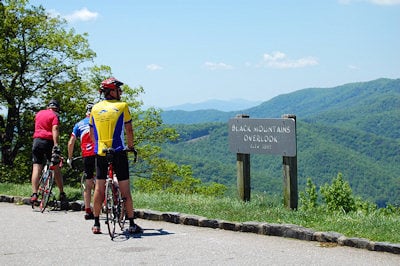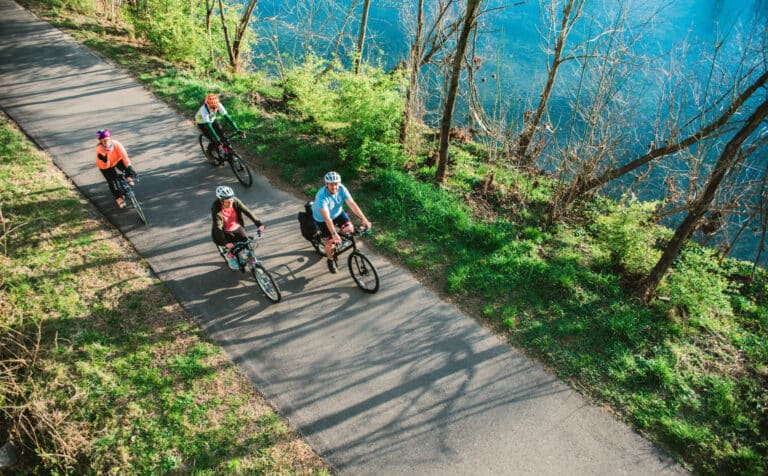The Blue Ridge Parkway is the single most popular road for bicyclists in the Blue Ridge. Cyclists cherish the Parkway’s 469 scenic miles from Shenandoah to the Smokies. Even Lance Armstrong pedaled the high-elevation road during his Tour de France championship training.
Unfortunately, the Blue Ridge Parkway’s newly released draft management plan could limit cycling on the Parkway. The draft plan focuses exclusively on the Parkway being “actively managed as a traditional, self-contained, scenic recreational driving experience.”
The Parkway was formed through legislation in 1936. But a “traditional driving experience” in 1936 is far different than how users would choose to enjoy the Parkway in the 21st century. Motorized vehicles should not be the only way promoted to experience the Blue Ridge Parkway today.
The Draft Plan also states that the Blue Ridge Parkway is applying for National Historic Landmark status, as a way to manage the Parkway under the strain of diminishing National Park budgets. Under this status, any changes within the Parkway will go under intense historic review, which could block trail building, road maintenance, or future improvements for bicycle access. Despite the growing interest in bicycling, Park managers may not be able to accommodate cyclists or other non-motorized and alternative transportation users.
Here are the alternatives listed in the plan:
- A = no change
- B = promoting the “driving experience”
- C = partnership with local economies
None of the alternatives are entirely bicycle-friendly, but B is the least bicycle-friendly of all. The Park has tentatively selected Alternative B, but public comment can change their decision.
The Parkway is overwhelmed and underfunded in trying to meet the needs of almost 20 million annual visitors. But on all counts, this draft plan fails to meet the vision created by Secretary of the Interior Ken Salazar’s Great Outdoors initiative, which includes a goal of connecting Americans to the outdoors. It further derails Director of the National Park Service Jon Jarvis’s challenge to Park managers to:
- expand the use of our National Parks for outdoor recreation;
- connect parks in or near urban areas through public transportation, and pedestrian and bike paths; and,
- decrease carbon footprint, and showcase the value of renewable energy.
What You Can Do
Submit written comments on the Blue Ridge Parkway Draft Management Plan by December 16, to:
Superintendent Philip A. Francis, Jr.
Blue Ridge Parkway
199 Hemphill Knob Road
Asheville, NC 28803
Or formally submit comments through the on-line system, answering the following questions:
Question 1: What proposals or aspects do you like/dislike about the alternatives in this Draft General Management Plan/Environmental Impact Statement (DGMP/EIS)?
I can support proposed Option C only if comprehensive changes are made to include and promote bicycling, walking and other non-motorized forms of transportation as an integral part of the Parkway’s mission.
As a cyclist, I cannot support the over-arching goals presented in the Draft Management Plan Environmental Impact Statement.
First, a National Historic Landmark designation is the wrong way to protect the Parkway. This status will create obstacles and bureaucratic red tape, and entomb the Parkway in a virtual time capsule. Instead, we should trust the good judgment and stewardship of future generations to preserve and protect this treasure in perpetuity, while meeting the changing needs of our citizens.
Second, Park managers need to understand that the legislation that created the Parkway as a “driving experience” doesn’t fully meet the needs of today’s Parkway users, or potential users. The Parkway shouldn’t be promoted as a car-only roadway, but should meet the National Park Service’s Call to Action and Secretary Salazar’s vision of Connecting Americans to the Great Outdoors. By promoting and accommodating cycling and other forms of alternative transportation, Parkway managers will provide interactive and lasting experiences with one of America’s most loved treasures.
Finally, the Draft Plan’s alternatives do not address the growing interest in cycling, and fail to acknowledge the benefits that cycling brings to both the Parkway and surrounding communities. The Blue Ridge Parkway is an international cycling destination, and important recreation facility for surrounding communities; vital to their economies, and to provide them with healthy lifestyle opportunities.
Merely allowing cycling on the Parkway is not enough and the message to promote active, healthy use of the facility must be an integral part of the core management plan.
Question 2: Do you have any suggestions for improving the preferred alternative in this DGMP/EIS? If so, what are they?
Parkway management should:
1) halt the National Historic Landmark application process;
2) recognize and promote cycling in the Draft Management Plan as a viable and important aspect of Parkway visitation;
3) modify the Draft Management Plan as presented and work with cyclists, the surrounding communities and the general public to meet the needs of today’s changing world. The plan should have a goal of building cycling and alternative transportation into the park planning process in order to meet the National Park Service’s Call to Action and Secretary Salazar’s vision for Connecting American’s to the Great Outdoors.
You can read more about the Parkway plan and its impact on cyclists here.








